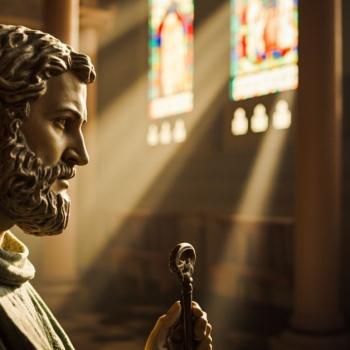"To a Franciscan, the whole world is a tabernacle." People who draw energy and inspiration from God's creation naturally want to preserve it. Their spirituality might find expression in recycling, organic gardening, working for cleaner air and water, preserving the rainforest, or dedication to other environmental issues. Sitting quietly beside a stream reminds them of the flow of God's life, the abundance of God's care, the essence of God's nature, which is infinitely creative.
Ignatian/Stand for justice
Ignatian spirituality is best summarized by the motto, "finding God in all things." One of the finest contemporary interpreters of this style is William Barry, SJ, author of Finding God in All Things and God's Passionate Desire and Our Response.
St. Ignatius believed our deep desires are healthy, leading us towards the God who made us. While this may seem mysterious, we ultimately long for union with God. The founder of the Jesuits encouraged people to develop an intimate relationship with a God who isn't punitive, tyrannical or obsessed with rules. Instead, this God desires what is best for us, and God's creative actions bring it about. Our task is to align our desires with God's. We discern the path for which we were created by noting whether we feel empowered and joyful about a decision, or depressed and drained by it.
In this style, we look at the texts of our lives to see where God is active. We savor what Ignatius called the "consolations," seeing what has brought us peace and joy so we can repeat those experiences. We also look at the "desolations," which make us angry or miserable, with an intention of avoiding those situations. Over time, we establish a pattern of seeking what's life-giving, staying away from the pitfalls that distract from God's peace.
Solidarity
We stand with each other because God first stood with us. Symbolically, this incarnation is represented in the mingling of water and wine during the Eucharistic liturgy. "By the mystery of this water and wine, may we come to share in the divinity of Christ who humbled himself to share in our humanity," we pray. The only way the Jewish and Christian people have known God is as part of the struggle. The Bible shows God active in storms and upheavals, crisis and battle, tragedy and division. In the Old Testament, the priestly work of intercession meant identifying with the peoples' suffering.
After the Spanish conquest, the Mexican people were devastated. They had nothing left, and harbored a collective death wish. When Mary appeared ten years later as one of them, a native woman at Guadalupe, she restored their will to live. If God stands with us, and we stand together, we have less to fear than as shaky individuals.
A spirituality which tries to isolate itself from the world's sorrows is doomed to fail. In fact, as Kenneth Leech points out in True Prayer, "The word private comes from the Latin privatio, which means robbery. To the Christian, nothing is private, least of all prayer.... That is the meaning of the symbol of the Trinity: that in God there is social life, community, sharing."
This may not translate to gigantic deeds, but to simple practices such as turning off the TV, listening instead to a child's rambling story, answering the phone even when caller ID signals an annoying acquaintance, sending a card or e-mail to one who's grieving. At a national level, it's writing congresspersons to assure children's health insurance, or participating in the growing movement to close the school of the Americas. Christians in Latin America have given us not only the name for the struggle, "la lucha," but also the image: together, we can more effectively fight injustice and bring God's kingdom than we can alone.
Thomistic/Intellectual Vigor
Some like a logical, carefully reasoned, thoughtful approach to faith. They enjoy brilliant works like Thomas Aquinas' Summa Thelogica or Teresa of Avila's Interior Castle. They don't respond eagerly to guided meditation or liturgical dance; they have a passion for truth and order.
A form of prayer which appeals to these thinkers is "lectio divina," with its orderly four steps: slowly reading a Scripture passage, meditating on God's message within it; praying over it and contemplating its meaning.
Thinkers like an approach that's not "touchy-feely." Scholars at universities can present the orderly structure of Christian belief without embarrassment. It contains elegant proofs for God's existence and moral behavior, fascinating background on scripture, enough thought-provoking material to engage a seeker throughout a lifetime.
The dimension of learning seems sadly neglected when people proclaim, "We've always done it this way." "Not exactly," the scholar responds. "The practice of Confirmation changed dramatically in the 9th century, as did clerical celibacy in the 11th." Studying church history gives a sense of where we've been, and how that affects where we're going.
Some spiritual directors say that the only way we can fail at prayer is by not showing up. Surveying many spirituality styles, we can appreciate the healthy variety of a smorgasbord which nurtures at the deepest level. As the Italians say, "mange bene," come and eat—well.
This piece first appeared in St. Anthony's Messenger in 2009 and is reprinted here by permission of the author.





